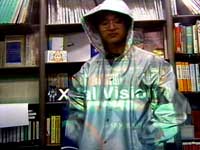slėpynės XXI amžiuje: plasmoninis lietpaltis
kol kas galimybės yra ribotos ir dienos šviesoje neleistų paslėpti žmogaus arba transporto priemonės,
tačiau šioks toks progresas visgi yra palyginus su įprastomis slėpynėmis krūmuose,
antiradarais ir veido kaukėmis a la pavasaris Pietų Amerikos pelkėse:
Electron effects could stop objects from scattering light.
The idea of a cloak of invisibility that hides objects from view has long been confined to the more improbable reaches of science fiction.
But electronic engineers have now come up with a way to make one.
Andrea Alù and Nader Engheta of the University of Pennsylvania in Philadelphia say that a 'plasmonic cover' could render objects "nearly invisible to an observer".
Their idea remains just a proposal at this stage,
but it doesn't obviously violate any laws of physics.
........
Scatter-brained
The key to the concept is to reduce light scattering.
We see objects because light bounces off them; if this scattering of light could be prevented (and if the objects didn't absorb any light) they would become invisible.
Alù and Engheta's plasmonic screen suppresses scattering by resonating in tune with the illuminating light.
Plasmons are waves of electron density, caused when the electrons on the surface of a metallic material move in rhythm.
The researchers say that a shell of plasmonic material will scatter light negligibly if the light's frequency is close to the resonant frequency of the plasmons.
The scattering from the shell effectively cancels out the scattering from the object.
For visible-light shielding, says Engheta, nature has already provided suitable plasmonic materials: silver and gold.
To reduce the scattering of longer-wavelength radiation such as microwaves, one could make the shield from a 'metamaterial':
a large-scale structure with unusual electromagnetic properties, typically constructed from arrays of wire loops and coils.
Alù and Engheta's calculations show that spherical or cylindrical objects coated with such plasmonic shields do indeed produce very little light scattering.
It is as though, when lit by light of the right wavelength, the objects become extremely small, so small that they cannot be seen.
...........
nuorodos:
http://www.nature.com/news/2005/050228/full/050228-1.html
http://arxiv.org/abs/cond-mat/0502336
yra ir kitas
Optinės maskuotės projektas:

